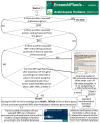AtSNP_TATAdb: Candidate Molecular Markers of Plant Advantages Related to Single Nucleotide Polymorphisms within Proximal Promoters of Arabidopsis thaliana L
- PMID: 38203780
- PMCID: PMC10779315
- DOI: 10.3390/ijms25010607
AtSNP_TATAdb: Candidate Molecular Markers of Plant Advantages Related to Single Nucleotide Polymorphisms within Proximal Promoters of Arabidopsis thaliana L
Abstract
The mainstream of the post-genome target-assisted breeding in crop plant species includes biofortification such as high-throughput phenotyping along with genome-based selection. Therefore, in this work, we used the Web-service Plant_SNP_TATA_Z-tester, which we have previously developed, to run a uniform in silico analysis of the transcriptional alterations of 54,013 protein-coding transcripts from 32,833 Arabidopsis thaliana L. genes caused by 871,707 SNPs located in the proximal promoter region. The analysis identified 54,993 SNPs as significantly decreasing or increasing gene expression through changes in TATA-binding protein affinity to the promoters. The existence of these SNPs in highly conserved proximal promoters may be explained as intraspecific diversity kept by the stabilizing natural selection. To support this, we hand-annotated papers on some of the Arabidopsis genes possessing these SNPs or on their orthologs in other plant species and demonstrated the effects of changes in these gene expressions on plant vital traits. We integrated in silico estimates of the TBP-promoter affinity in the AtSNP_TATAdb knowledge base and showed their significant correlations with independent in vivo experimental data. These correlations appeared to be robust to variations in statistical criteria, genomic environment of TATA box regions, plants species and growing conditions.
Keywords: TATA box; TATA-binding protein; estimates in silico; gene expression; genome-wide analysis; noncoding polymorphism; target-assisted breeding; verification in vivo.
Conflict of interest statement
The authors declare no conflicts of interest.
Figures






Similar articles
-
Human_SNP_TATAdb: a database of SNPs that statistically significantly change the affinity of the TATA-binding protein to human gene promoters: genome-wide analysis and use cases.Vavilovskii Zhurnal Genet Selektsii. 2023 Dec;27(7):728-736. doi: 10.18699/VJGB-23-85. Vavilovskii Zhurnal Genet Selektsii. 2023. PMID: 38213714 Free PMC article.
-
Candidate SNP Markers of Atherogenesis Significantly Shifting the Affinity of TATA-Binding Protein for Human Gene Promoters show stabilizing Natural Selection as a Sum of Neutral Drift Accelerating Atherogenesis and Directional Natural Selection Slowing It.Int J Mol Sci. 2020 Feb 5;21(3):1045. doi: 10.3390/ijms21031045. Int J Mol Sci. 2020. PMID: 32033288 Free PMC article.
-
Disruptive natural selection by male reproductive potential prevents underexpression of protein-coding genes on the human Y chromosome as a self-domestication syndrome.BMC Genet. 2020 Oct 22;21(Suppl 1):89. doi: 10.1186/s12863-020-00896-6. BMC Genet. 2020. PMID: 33092533 Free PMC article.
-
TATA box polymorphisms in human gene promoters and associated hereditary pathologies.Biochemistry (Mosc). 2009 Feb;74(2):117-29. doi: 10.1134/s0006297909020011. Biochemistry (Mosc). 2009. PMID: 19267666 Review.
-
On the Role of TATA Boxes and TATA-Binding Protein in Arabidopsis thaliana.Plants (Basel). 2023 Feb 22;12(5):1000. doi: 10.3390/plants12051000. Plants (Basel). 2023. PMID: 36903861 Free PMC article. Review.
References
MeSH terms
Substances
Grants and funding
LinkOut - more resources
Full Text Sources

